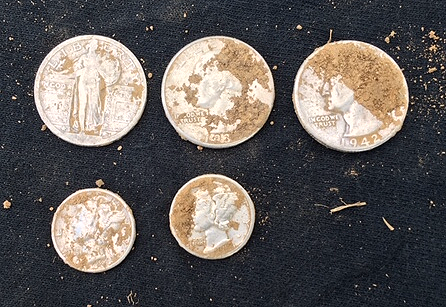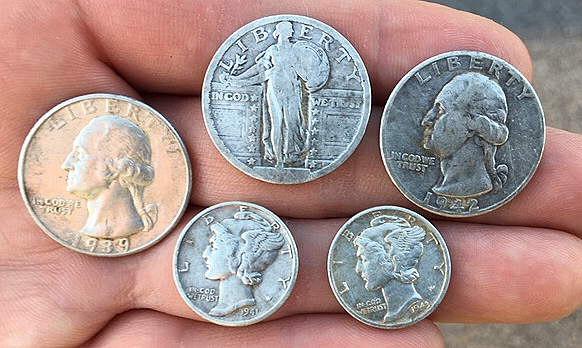I haven’t had a 5 silver day in forever. Literally, the very first swing of the day was a solid silver quarter sound, and there it was. It was an awkward spot: a sliver of grass between a large light pole and the edge of the parking lot. Awkward spots on the fringes often hide silvers.
Seemed like a good omen, but then an hour of nothing, not even much clad or any wheaties. Then I started hitting deep clad, which is always a good sign. Then hit a signal dancing between a wheatie and a silver, and was disappointed that it was only a wheatie.
But rescanned the hole, and the silver was loud and clear, a dateless SLQ. To any newbies, always rescan your holes.
Not 5 minutes later, hit another silver sound, and it was a merc. Rolled the pinpointer around the hole again, and another merc. To any newbies, always rescan your holes.
Then, pretty much the next swing, hit another silver quarter. 4 silvers in under 10 minutes. Counting the first one of the day, it was 5 silvers in about 75 minutes, and this site generally runs 1 silver per 2 hours. Must have hit a little bit of a hot spot there. Maybe a picnic table was there in the past, that not only concentrated people, but locked out the detectorists that came before me.
The rest of the hunt, tho, produced nothing, but 5 silvers in 3 hours isn’t too bad.



Nice, never had a 3-silver quarter day. Those all could have been lost within a short time, based on their wear. Why is deep clad a good sign? I like those spots too but the ones I find seem to only produce deep clad and I figure either the dirt has been turned, or else the coins sink fast there and the silver is already at an unreachable level. Or is it just that it makes it obvious that no one has detected the site well?
If I am getting deep 60s/70s clad I take it as a sign the site was not detected in the 80s. I almost always get something good at such as site.
I developed ,my deep clad theory at a site where I found over 100 silvers. I always wondered why I did so well there, as the site was an old school converted to an office building, and the old sports fields were clearly visible on the 1930s aerials, and where they were was still public property.
I milked it for all it had, then went back a few years later, and think I figured it out. They stopped mowing it. My theory was that they probably didn’t ,mow it since the 60s or 70s, and therefore had not been detected, or detected well, and for whatever reason, they mowed it the year I found it.
Had the same experience at another site; the land just turned over to be a park and mowed. Got 65 silvers of the there, and would have gotten more if there wasn’t another guy in there with an E-Trac. But, the deep clad from the 60s/70s gave it away.
Thanks for that insight. I was on such a site today. In three hours I found three silver FDR dimes and 27 clad quarters. The clay on this site keep most of the oldest coins only six inches deep (but the Etrac thinks they are 7-9 inches deep). I never find many wheats at such a site, I think the clay keeps them wet and they turn into unrecognizable green blobs at some point. I should try digging some odd numbers, I know they are down there, but I am happy with the silver. This is the 3rd time I have hunted this site and the deep clad seems to be regenerating itself!